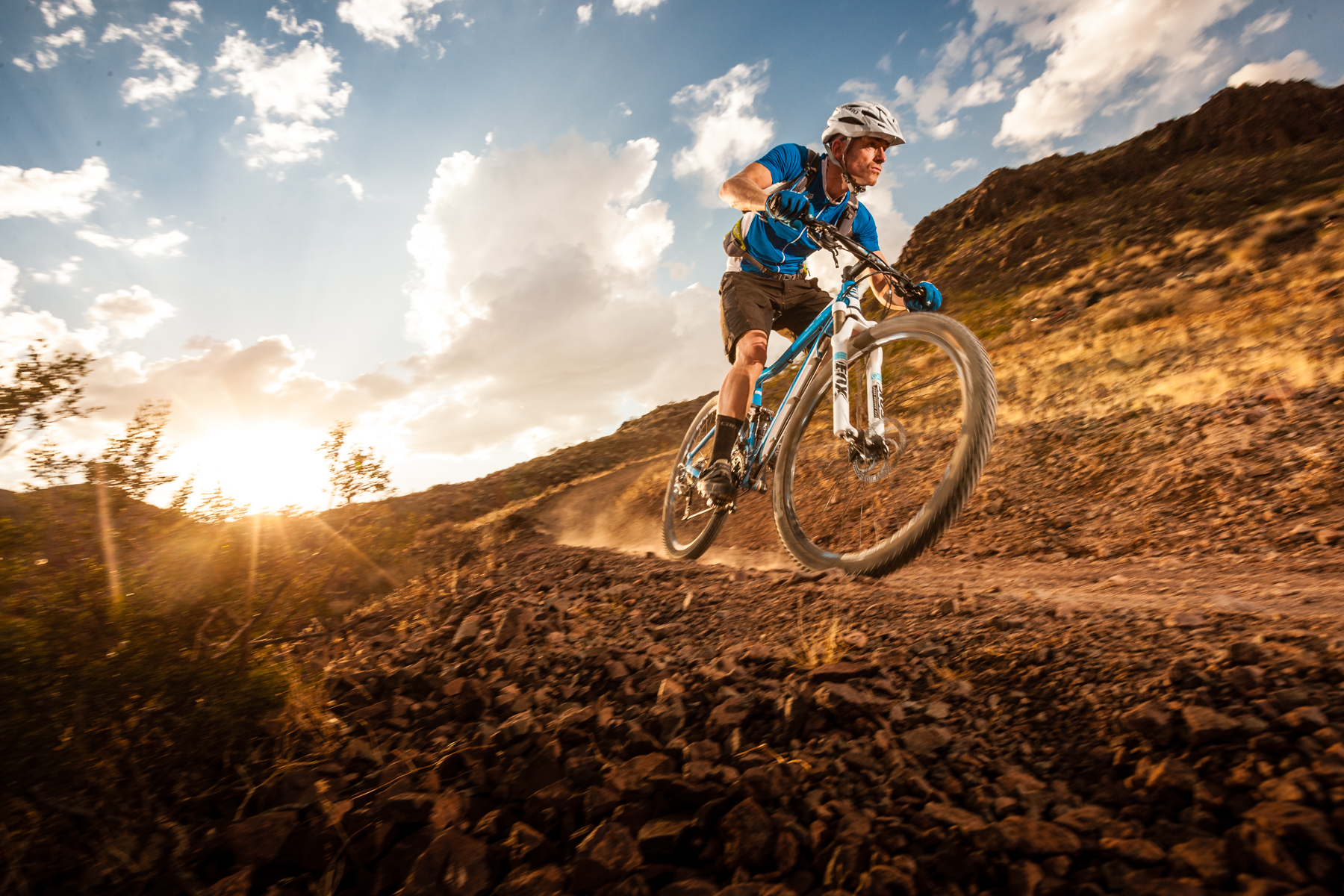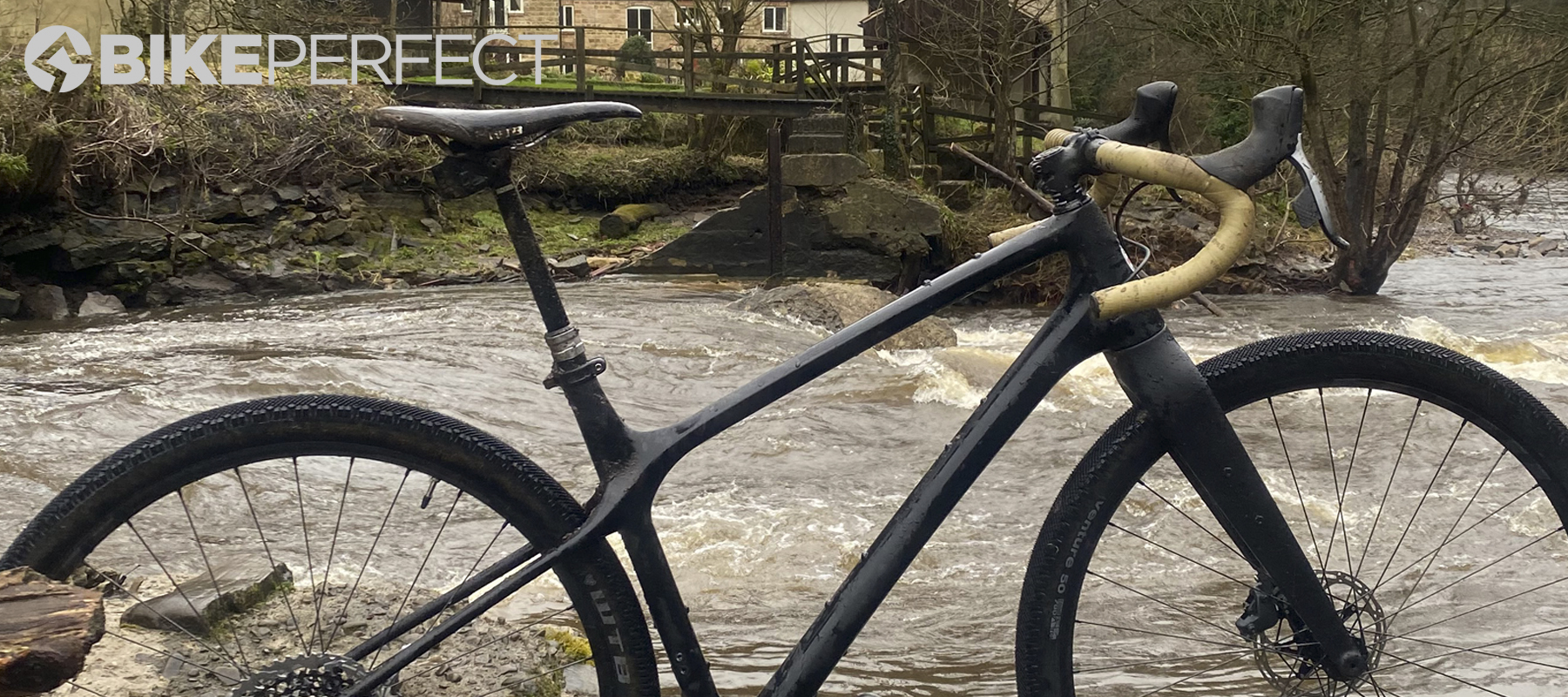Bike Perfect Verdict
Potentially high performance gravel/adventure ride but radical handling and restricted upgradeability are a real divider
Pros
- +
Radical looks create a stir wherever you ride
- +
Lightweight, performance-tuned frame and fork with sorted storage fixtures
- +
Amazing stability for steeps and straight lines in stock format
- +
SRAM AXS hybrid gravel/MTB equipment is awesome
Cons
- -
Stock bars are too narrow and stem too short for the stubborn handling
- -
Fitting a short enough stem leaves reach compromised
- -
Firm ride and no scope for fat tyre or suspension fork fixes
- -
Expensive
Why trust BikePerfect
Evil has a rep for pushing the limits with its bike design and company attitude and it has really gone radical with its brand-new Chamois Hagar gravel bike. But do MTB angles, with a unique geometry fork and gravel bike clearances work or is it all a bit wonky?
Design and geometry
When we say radical, we really mean it. Judging by the social media comments we’ve had over an extended test period you’ll either think it’s ‘totally awesome’ or 'it looks like someone broke its back’. In terms of numbers, they translate into a custom 428mm length, 57mm offset rigid carbon fork that sits at a 66.67-degree head angle in the super low, long reach top tube frame. The bottom bracket hangs 80mm below the axles to keep the centre of gravity as low as possible.

Symmetrical ‘jaw bone’ chainstays swinging back and down below the bottom bracket keep chainstay length relatively short for the off-road drop bar species at 430mm. The stretched front end means no toe/wheel conflict when turning either. Gravel/road width 100x12/142x12 axles (rather than 110x15/148x12 Boost) means there’s only clearance for a 50mm/1.9in tyre though so it can’t compete with adventure bikes like Salsa’s new Cutthroat when it comes to rubber capacity. The super-low bottom bracket also means anything under 700x34mm or 650x50mm will put the pedals too low.
You certainly can’t accuse Evil of lacking mounting points though, with seven different bottle mounts that can also be used for bolt-on fork- and top-tube bags. There are hidden fixtures for mudguards/fenders and a bolt-on mount to add a front mech but either of those will drop tyre clearance down to 40mm. There’s thick rubber protection on the chainstay and underbelly and weather-plugged internal routing for gears, brakes and dropper post. The frame and fork also available separately for €2,999.99 and at 1145g frame, 467g (uncut) fork it’s a competitively lightweight considering the stretched dimensions.
Incidentally to answer the other chatter on social media, no you can’t just stick a suspension fork in and call it a mountain bike. The offset of the fork and the super low bottom bracket height means Evil says it isn’t compatible and there’s no width in the back end to take Boost wheels and modern MTB-sized tyres.
Components and build
The spec of our test bike definitely dances on the gravel/MTB line though as we got treated to the full SRAM Force AXS wireless experience including Reverb AXS wireless dropper. Evil has also used AXS's genre-spanning capability to fit an XO1 Eagle rear mech and 12-speed 10-50T Eagle cassette. That gives a 500% gear range that’s enough to spin from 50kph+ on the road or winch up the steepest climbs the tyres can grip.

If it’s dry/dusty/gravelly the ultra close-packed, chevron tread fins of the 50mm WTB Venture tyres gives serious micro adhesion as well as a thick carpet for fighting off pinch and pointy punctures. Mix in some damp though and you’ll be spinning and sliding very soon unless you get it over onto its toothier edges hard and early. If you’re dropping €5,999.99 on a bike though, you’ll probably have enough cash to rack up a range of different tyres for different surfaces. Those on a budget - or just into wires over wireless controls - have the option of a Shimano GRX 810 build which again uses a mountain bike cassette (11-speed 11-46T XT) and a BikeYoke dropper post operated by the left hand ‘shifter.’
Either way, alloy WTB wheels put it roughly on par with premium competition such as Santa Cruz’s Stigmata but disappointing compared to the SRAM Force AXS Cervelo Aspero which rolls on DT carbons. The Easton bars are carbon fibre but what really matters to the ride is not the material but the dimensions.
Ride, handling and performance
That’s because the long 93mm trail, 736mm front centre and low-slung 80mm bottom bracket drop dimensions all create a bike that really doesn’t like changing direction. On the upside, that means masses of straight-line stability for plugging through sand or ploughing over pebbles and ruts that would be twitching the front wheel of a normal gravel bike all over the place. Once you’ve got it leaned into a turn, that grounded centre of gravity scythes round with huge amounts of authority and when the tyres let go it drifts comically well. Hunkering down with a dropper post obviously increases that sense of security - as well as adding an aero edge too.
The trouble is starting that turn, or making any sort of fine adjustment was a lot harder than normal with the 44mm bar of our medium sample. The fact that there’s obviously no fork compression when you brake coming into the turn to steepen the head angle momentarily and initiate the turn doesn’t help either. When it does turn it then lurches dramatically rather than tweaking slightly. Because the bike isn’t moving when you expect we often found we'd shifted body weight prematurely and then had to overcompensate back again.
As a result, while we spent a lot of our early rides either running wide, clipping trees or picking ourselves out of ditches as soon as the trails got twisty. Even in faster, more open road/gravel situations the stubbornness starting a turn and refusal to change the arc or re-balance slightly mid-turn led to awkward moments as we begged the Evil to play nicely. It felt wonky as hell out of the saddle too, flopping around and tripping up when you get your weight forward. Don’t think we’re just roadies used to 100mm stems and steering angles beginning with a seven here either. My regular ride has a 65-degree head angle and I love a 63.5-degree if I’m working at warp speed.
The good news is that the steering can be ‘fixed’ to a varying degree. A 460mm bar (standard issue on large and extra-large) in the 50mm stem adds enough leverage to manage the stubbornness. It’s still definitely a case of ‘managing it’ than it feeling intuitive though. Thankfully fitting the shortest stem possible - a 32mm reach Pace RC46 - provided the eureka moment. The steering felt light, intuitive and reacted fast enough to catch traction or shift body weight before we’d consciously thought about it but we still benefited from the extra stability. That meant we could storm through technical sections of roots, rocks or baby-head rocks with the reckless abandon and comical control levels we’ve come to expect from Evil’s mountain bikes. While it’s weird seeing almost the whole headtube in front of the stem when you look down it also feels fine on the road and out of the saddle in a progressive-MTB-not -traditional-road-bike way. Moving your weight back further behind the wheel also lets the bike move more easily over impacts so it feels smoother too.

The problem (being able to see the whole head tube is a bit of a giveaway) is that the bar-to-seat-clamp measurement was now 40-50mm than our normal gravel setup on a medium-sized frame. With a 745mm bottom-bracket-to-saddle-to-top measurement we only had 10mm of shaft showing between the Reverb collar and the seat collar of the extended seat tube. That means we’d have to go for a shorter 125mm drop or a rigid post to get a low enough saddle height on a large, and even then it’s only 20mm longer so still on the cramped side.
While the handling is obviously the dominant part of the bike’s character it’s not the only part of the ride. Frame and fork feel are definitely on the purposeful-not-plush side, so even with just 30psi in the Venture tyres you’ll get thumped and jolted around on rougher trails. As mentioned before there’s no scope to go bigger with tyres or fit a suspension fork either. The flip side is a direct and punchy feel under power that helps offset the 9.5kg overall weight. If you went lighter with wheels, tyres and a rigid post you could definitely make more of that performance potential, too. If you can afford it though we’d definitely get the AXS shifting and SRAM brakes as even when the handling was really doing our head in at first, the wireless stop-and-go control never failed to impress us.
Verdict
Bikes only get better by brands pushing the boundaries and Evil deserves credit for creating a bike that’s generated a huge amount of buzz in the bike industry and turns heads wherever you ride it or post pictures on social. With different tyres, it’d be a light and punchy performer for gravel racing, and it’s fully fixtured for adventuring or taking the rough route into work and back.
Unfortunately, while it turns heads the radical geometry means it’s reluctant to actually turn - particularly in the smaller sizes with narrower bars. The inability to subtly/instinctively tweak lines, re-balance the bike and chase traction really undermines the obvious stability gains in steep or technical situations, too.
Fitting wider bars definitely helps move it into the 'you’ll get used to it and then it’s great for more gnarly stuff' category. However, fitting a stem short enough to really hit the steering sweet spot leaves it very short on reach unless you up-size the frame and shorten the dropper. We can see a lot of potential Evil owners from the MTB side being frustrated by the fact they can’t stick their Boost wheels and bigger tyres in for more rugged Monstercross riding. It’s also damned expensive for a direct buy rather than primarily shop sourced bike.
Test conditions
- Temperature range: 2-10 degrees
- Surface: Mixed dirty woods, gravel tracks, moorland back roads and local urban day and night
- Route: Nidderdale, Washburn valley, North York Moors, True Grit Dark Skies event
Tech spec: Evil Chamois Hagar SRAM AXS
- Price: €5,999.99
- Frame: Carbon frame and fork
- Size: Medium
- Weight: 9.4kg
- Groupset: SRAM Eagle AXS
- Crankset: SRAM Force 38T chainset, SRAM X01 AXS 10-50T 12-speed
- Wheels: WTB Pro Terra wheels
- Tyres: WTB Venture 50mm tyres
- Brakes: SRAM Force 160mm brakes
- Bar/stem: Evil 50mm stem with Easton EA70 AX 440mm bar
- Seatpost: RockShox Reverb AXS 150mm stroke dropper post
- Saddle: WTB SL8 Pro saddle

Guy Kesteven has been working on Bike Perfect since its launch in 2019. He started writing and testing for bike mags in 1996. Since then he’s written several million words about several thousand test bikes and a ridiculous amount of riding gear. He’s also penned a handful of bike-related books and he reviews MTBs over on YouTube.
Current rides: Cervelo ZFS-5, Specialized Chisel, custom Nicolai enduro tandem, Landescape/Swallow custom gravel tandem
Height: 180cm
Weight: 69kg

